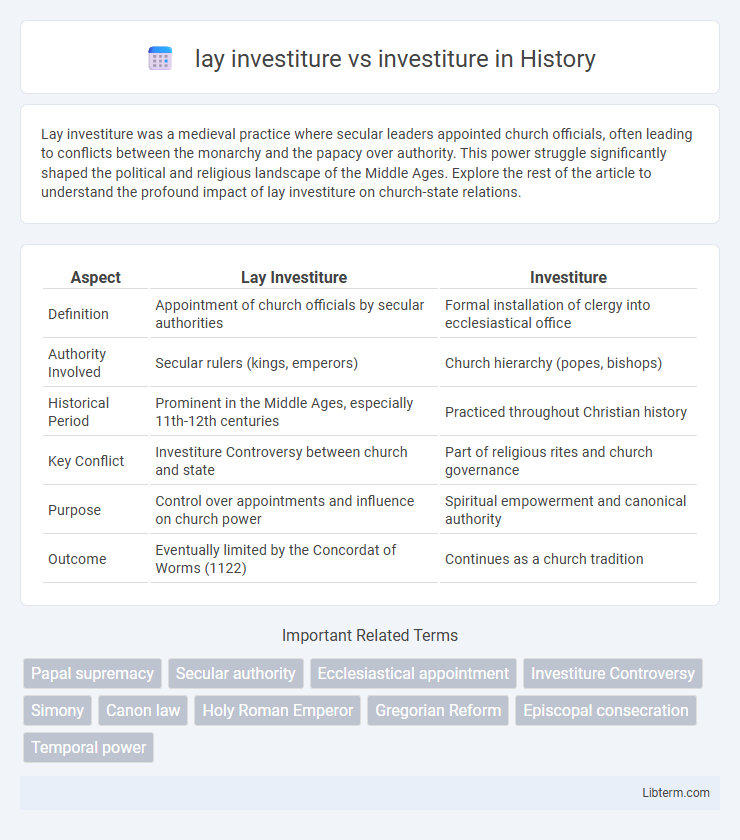Lay investiture was a medieval practice where secular leaders appointed church officials, often leading to conflicts between the monarchy and the papacy over authority. This power struggle significantly shaped the political and religious landscape of the Middle Ages. Explore the rest of the article to understand the profound impact of lay investiture on church-state relations.
Table of Comparison
| Aspect | Lay Investiture | Investiture |
|---|---|---|
| Definition | Appointment of church officials by secular authorities | Formal installation of clergy into ecclesiastical office |
| Authority Involved | Secular rulers (kings, emperors) | Church hierarchy (popes, bishops) |
| Historical Period | Prominent in the Middle Ages, especially 11th-12th centuries | Practiced throughout Christian history |
| Key Conflict | Investiture Controversy between church and state | Part of religious rites and church governance |
| Purpose | Control over appointments and influence on church power | Spiritual empowerment and canonical authority |
| Outcome | Eventually limited by the Concordat of Worms (1122) | Continues as a church tradition |
Understanding Investiture: Definition and Historical Context
Investiture refers to the formal ceremony in which a person is granted authority or rank, historically significant in both religious and political spheres. Lay investiture specifically involves secular leaders, such as kings or nobles, appointing church officials, a practice that sparked major conflicts like the Investiture Controversy between the papacy and Holy Roman Empire in the 11th and 12th centuries. Understanding this distinction highlights the power dynamics and the evolving relationship between church and state during medieval Europe.
What is Lay Investiture? Key Concepts Explained
Lay investiture is the appointment of church officials, such as bishops or abbots, by secular authorities instead of religious leaders, a practice that historically sparked significant conflict between church and state. Key concepts include the authority struggle over who holds the power to appoint clergy, typically kings or emperors asserting control during the Middle Ages. This practice challenged the spiritual independence of the church and led to landmark conflicts like the Investiture Controversy in the 11th and 12th centuries.
Origins of Ecclesiastical Investiture Traditions
Lay investiture originated in the early Middle Ages when secular rulers, such as kings and emperors, appointed church officials, blending political power with religious authority. Ecclesiastical investiture, by contrast, developed from canonical traditions emphasizing the church's autonomy in conferring spiritual offices, rooted in the apostolic succession and papal authority. The Investiture Controversy of the 11th and 12th centuries highlights the conflict between these origins, ultimately shaping the separation between secular and ecclesiastical powers in appointing bishops and abbots.
Lay Investiture vs. Investiture: Core Differences
Lay investiture involves secular authorities appointing church officials, often causing conflicts over power between monarchy and clergy. Investiture, in contrast, is the formal ecclesiastical ceremony where bishops or abbots receive symbols of office from the church hierarchy, emphasizing spiritual authority. The core difference lies in lay investiture's political interference versus investiture's religious legitimacy.
The Role of Secular Authorities in Lay Investiture
Lay investiture involves secular authorities, such as kings or nobles, conferring church offices and symbols of spiritual authority, a practice that challenged the church's autonomy. Secular rulers exercised significant influence by appointing bishops and abbots, blending political power with religious control during the Middle Ages. This overlap often sparked conflicts like the Investiture Controversy, where the church sought to reclaim the right to invest clergy independently.
Papal Authority and Religious Investiture Practices
Lay investiture refers to the controversial practice in medieval Europe where secular rulers appointed bishops and abbots, challenging Papal authority by undermining the Church's exclusive right to invest clergy with spiritual symbols of office. Investiture in a religious context involves the formal conferral of ecclesiastical office, symbolized by elements like the ring and staff, reinforcing the Pope's supreme authority over Church leadership. The Investiture Controversy of the 11th and 12th centuries exemplified the struggle between Papal authority and secular powers, ultimately affirming the Pope's control over religious investiture practices and limiting lay influence.
The Investiture Controversy: Causes and Consequences
The Investiture Controversy centered on the conflict between secular rulers and the Church over the authority to appoint bishops and abbots, a practice known as lay investiture. This power struggle emphasized the tension between imperial control and papal independence, ultimately leading to the Concordat of Worms in 1122, which distinguished spiritual and temporal investiture powers. The controversy significantly reshaped medieval political and religious structures, reinforcing papal supremacy and limiting secular interference in ecclesiastical appointments.
Major Figures and Events in the Investiture Conflict
The Investiture Conflict prominently featured Emperor Henry IV and Pope Gregory VII as major figures, clashing over the right to appoint church officials, a practice known as lay investiture. Key events include Henry IV's 1077 Walk to Canossa, seeking papal absolution, and the 1122 Concordat of Worms, which resolved the dispute by delineating the powers of the emperor and the pope in investiture. This conflict significantly shaped the medieval church-state relationship and the subsequent development of ecclesiastical authority in Europe.
Long-term Impacts of Lay Investiture on Church-State Relations
Lay investiture, a medieval practice where secular rulers appointed church officials, significantly altered the balance of power between church and state by undermining ecclesiastical autonomy. This conflict sparked the Investiture Controversy, leading to the Concordat of Worms in 1122, which delineated the boundaries of authority and set a precedent for separation between spiritual and temporal powers. The long-term impact of lay investiture contributed to the evolution of church-state relations, fostering the development of political sovereignty and influencing the emergence of modern secular governance structures.
Legacy and Modern Perspectives on Investiture
Lay investiture, a medieval practice where secular leaders appointed church officials, significantly shaped the power dynamics between the church and state, leaving a legacy of contested authority and institutional boundaries. Modern perspectives on investiture emphasize the ceremonial and symbolic aspects, reflecting evolved roles where religious and political entities respect distinct domains and collaborate on governance. Contemporary investiture ceremonies continue to honor tradition while promoting transparency and legitimacy in leadership transitions.
lay investiture Infographic

 libterm.com
libterm.com